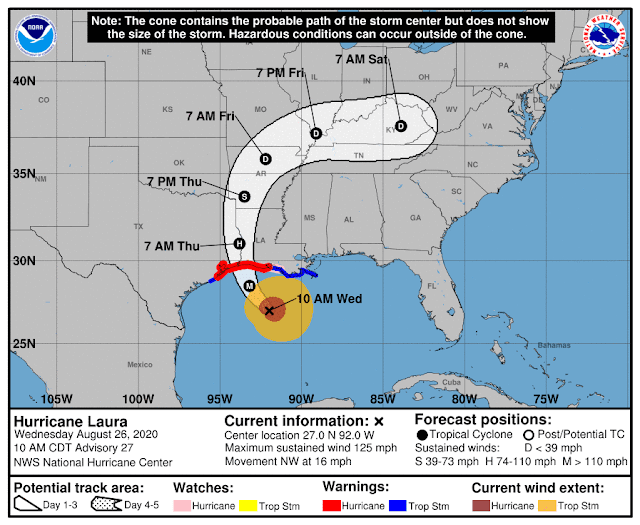Hurricane Laura rapidly intensified throughout the day on Wednesday and right up to landfall... similar to what Harvey did in 2017 and Michael in 2018. From 4pm CDT on Tuesday to 4pm on Wednesday, the central pressure fell by 43 mb, and the sustained winds increased by 65 mph, resulting in a jump from a Category 1 to a Category 4 hurricane. By the time it made landfall at 1am CDT on Thursday, the peak sustained winds were 150 mph (Category 5 technically begins at 156 mph), and the central pressure had fallen to 938 mb. The long radar loop of its approach is shown below -- the Lake Charles radar was lost at 1am CDT when the northern eyewall reached it, at which point I switched the source to the more distant Houston radar. There are other radar loops available at http://bmcnoldy.rsmas.miami.edu/tropics/radar/
The eye passed directly over the tiny coastal town of Cameron, which has been wiped off the map several times before by overwhelming storm surge (Audrey 1957, Rita 2005, Ike 2008). Fewer and fewer people remain each time, and Laura 2020 could be its end. It was reported that at least 100 of the 400 residents did not evacuate the town by Wednesday night.
It's too soon to know what the depth and extent of the storm surge was; that gets manually surveyed which can take at least a couple days for people to get around, locate, and survey high-water marks. But from a few tide gauge stations, it may have been 8-12 feet at its deepest, and that goes a long distance inland with low, flat land.
Laura's wrath does not end at landfall. The storm surge will take days to recede, but meanwhile, destructive winds follow it inland (it still has 120 mph sustained winds!!), as does very heavy rain and tornadoes. The flash flooding risk over the next three days is shown below. There's still a possibility that when Laura (or what's left of it) exits the U.S. east coast on Saturday, it could re-intensify over the warm ocean, though it will racing away toward Nova Scotia by then.
With this burst of high-intensity action, the seasonal ACE (Accumulated Cyclone Energy) has jumped up a bit to 182% of average for the date, using the past fifty years as the baseline. However, that excess drops to zero (average) on September 6 if no other activity occurs in the meantime.
Across the rest of the Atlantic, it's remarkably quiet for late August. The only feature of interest is a wave that is just exiting the African coast now. While there is some model support it developing in a few days, it's far from unanimous and there is plenty of time to watch it. But when the time comes, the next name on the list is Nana, and the record-earliest "N" storm formed on September 5 (Nate in 2005).
- Visit the Tropical Atlantic Headquarters.
- Subscribe to get these updates emailed to you.
- Follow me on Twitter















































 Tropical Depression 11 formed on the afternoon of the 11th, and struggled to intensify. But on Thursday morning, it finally did and was upgraded to Tropical Storm Josephine. Josephine is the tenth named storm of the season, crushing the previous earliest "J" storm formation record on August 22 (Jose in 2005). 2020 has now produced the record earliest C, E, F, G, H, I, and J storms! The record earliest K storm is Katrina, which formed on August 24, 2005... there is a really good chance that 2020 will beat that one too.
Tropical Depression 11 formed on the afternoon of the 11th, and struggled to intensify. But on Thursday morning, it finally did and was upgraded to Tropical Storm Josephine. Josephine is the tenth named storm of the season, crushing the previous earliest "J" storm formation record on August 22 (Jose in 2005). 2020 has now produced the record earliest C, E, F, G, H, I, and J storms! The record earliest K storm is Katrina, which formed on August 24, 2005... there is a really good chance that 2020 will beat that one too.


